2016 NISSAN MURANO HYBRID spare tire
[x] Cancel search: spare tirePage 387 of 443
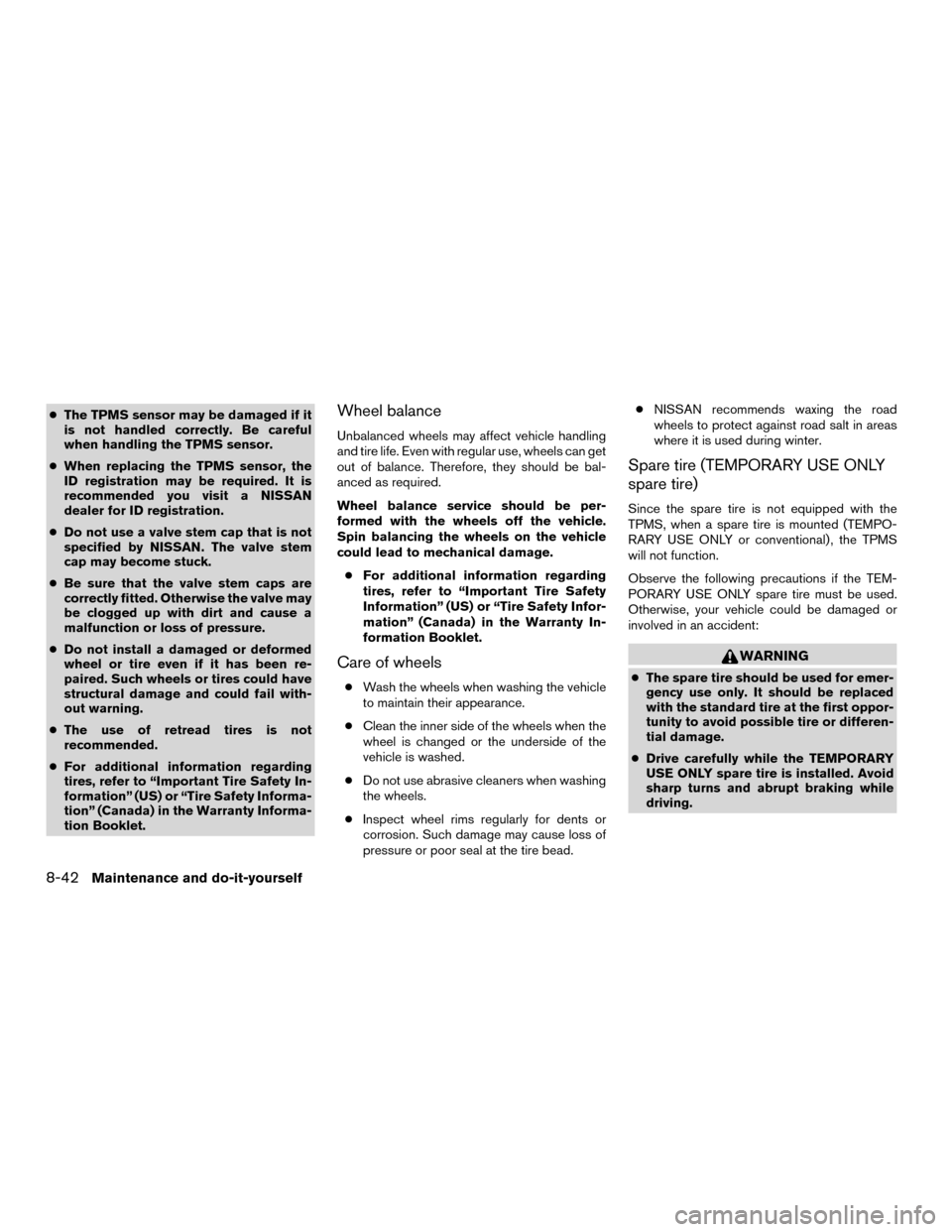
●The TPMS sensor may be damaged if it
is not handled correctly. Be careful
when handling the TPMS sensor.
● When replacing the TPMS sensor, the
ID registration may be required. It is
recommended you visit a NISSAN
dealer for ID registration.
● Do not use a valve stem cap that is not
specified by NISSAN. The valve stem
cap may become stuck.
● Be sure that the valve stem caps are
correctly fitted. Otherwise the valve may
be clogged up with dirt and cause a
malfunction or loss of pressure.
● Do not install a damaged or deformed
wheel or tire even if it has been re-
paired. Such wheels or tires could have
structural damage and could fail with-
out warning.
● The use of retread tires is not
recommended.
● For additional information regarding
tires, refer to “Important Tire Safety In-
formation” (US) or “Tire Safety Informa-
tion” (Canada) in the Warranty Informa-
tion Booklet.Wheel balance
Unbalanced wheels may affect vehicle handling
and tire life. Even with regular use, wheels can get
out of balance. Therefore, they should be bal-
anced as required.
Wheel balance service should be per-
formed with the wheels off the vehicle.
Spin balancing the wheels on the vehicle
could lead to mechanical damage.
● For additional information regarding
tires, refer to “Important Tire Safety
Information” (US) or “Tire Safety Infor-
mation” (Canada) in the Warranty In-
formation Booklet.
Care of wheels
●Wash the wheels when washing the vehicle
to maintain their appearance.
● Clean the inner side of the wheels when the
wheel is changed or the underside of the
vehicle is washed.
● Do not use abrasive cleaners when washing
the wheels.
● Inspect wheel rims regularly for dents or
corrosion. Such damage may cause loss of
pressure or poor seal at the tire bead. ●
NISSAN recommends waxing the road
wheels to protect against road salt in areas
where it is used during winter.
Spare tire (TEMPORARY USE ONLY
spare tire)
Since the spare tire is not equipped with the
TPMS, when a spare tire is mounted (TEMPO-
RARY USE ONLY or conventional) , the TPMS
will not function.
Observe the following precautions if the TEM-
PORARY USE ONLY spare tire must be used.
Otherwise, your vehicle could be damaged or
involved in an accident:
WARNING
●The spare tire should be used for emer-
gency use only. It should be replaced
with the standard tire at the first oppor-
tunity to avoid possible tire or differen-
tial damage.
● Drive carefully while the TEMPORARY
USE ONLY spare tire is installed. Avoid
sharp turns and abrupt braking while
driving.
8-42Maintenance and do-it-yourself
Page 388 of 443
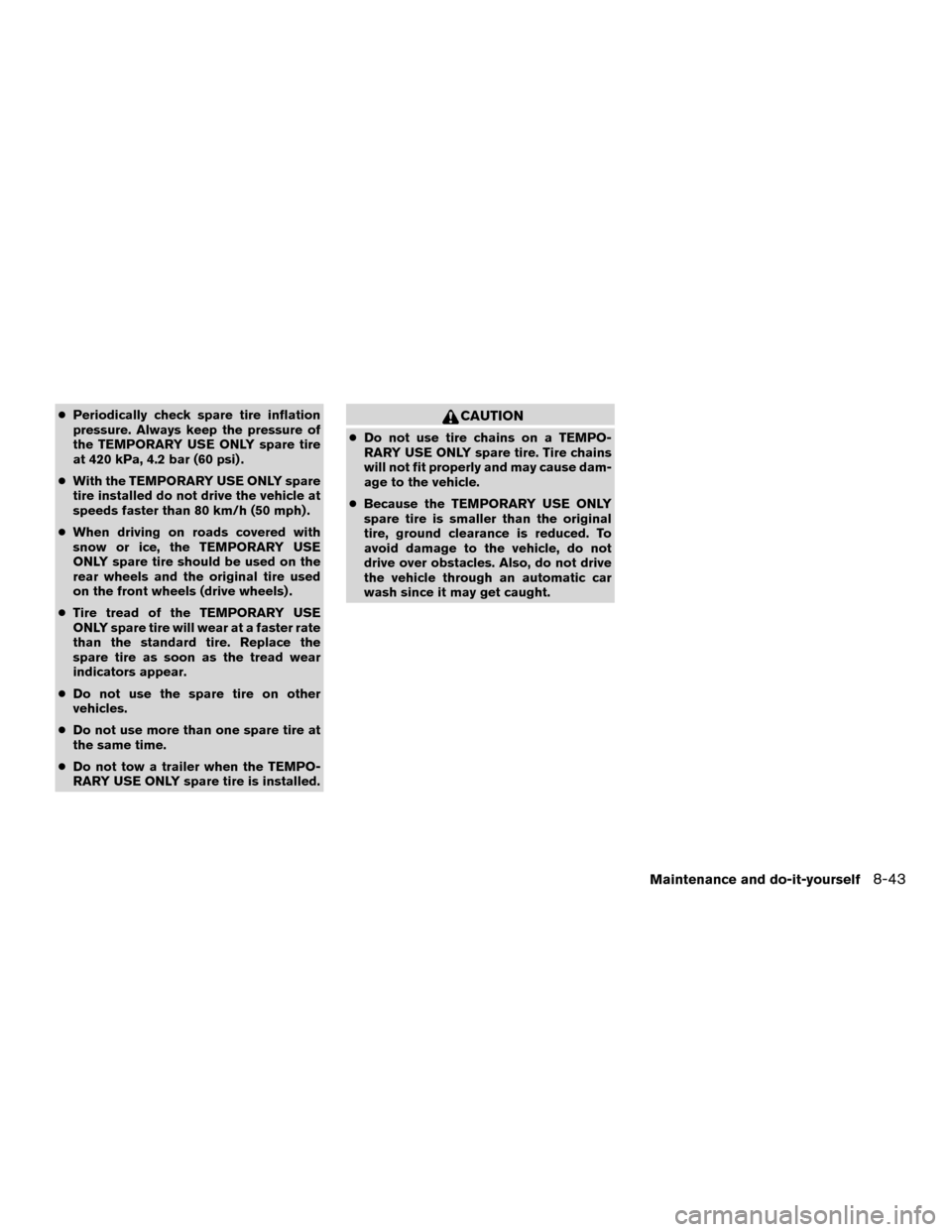
●Periodically check spare tire inflation
pressure. Always keep the pressure of
the TEMPORARY USE ONLY spare tire
at 420 kPa, 4.2 bar (60 psi) .
● With the TEMPORARY USE ONLY spare
tire installed do not drive the vehicle at
speeds faster than 80 km/h (50 mph) .
● When driving on roads covered with
snow or ice, the TEMPORARY USE
ONLY spare tire should be used on the
rear wheels and the original tire used
on the front wheels (drive wheels) .
● Tire tread of the TEMPORARY USE
ONLY spare tire will wear at a faster rate
than the standard tire. Replace the
spare tire as soon as the tread wear
indicators appear.
● Do not use the spare tire on other
vehicles.
● Do not use more than one spare tire at
the same time.
● Do not tow a trailer when the TEMPO-
RARY USE ONLY spare tire is installed.CAUTION
●Do not use tire chains on a TEMPO-
RARY USE ONLY spare tire. Tire chains
will not fit properly and may cause dam-
age to the vehicle.
● Because the TEMPORARY USE ONLY
spare tire is smaller than the original
tire, ground clearance is reduced. To
avoid damage to the vehicle, do not
drive over obstacles. Also, do not drive
the vehicle through an automatic car
wash since it may get caught.
Maintenance and do-it-yourself8-43
Page 398 of 443
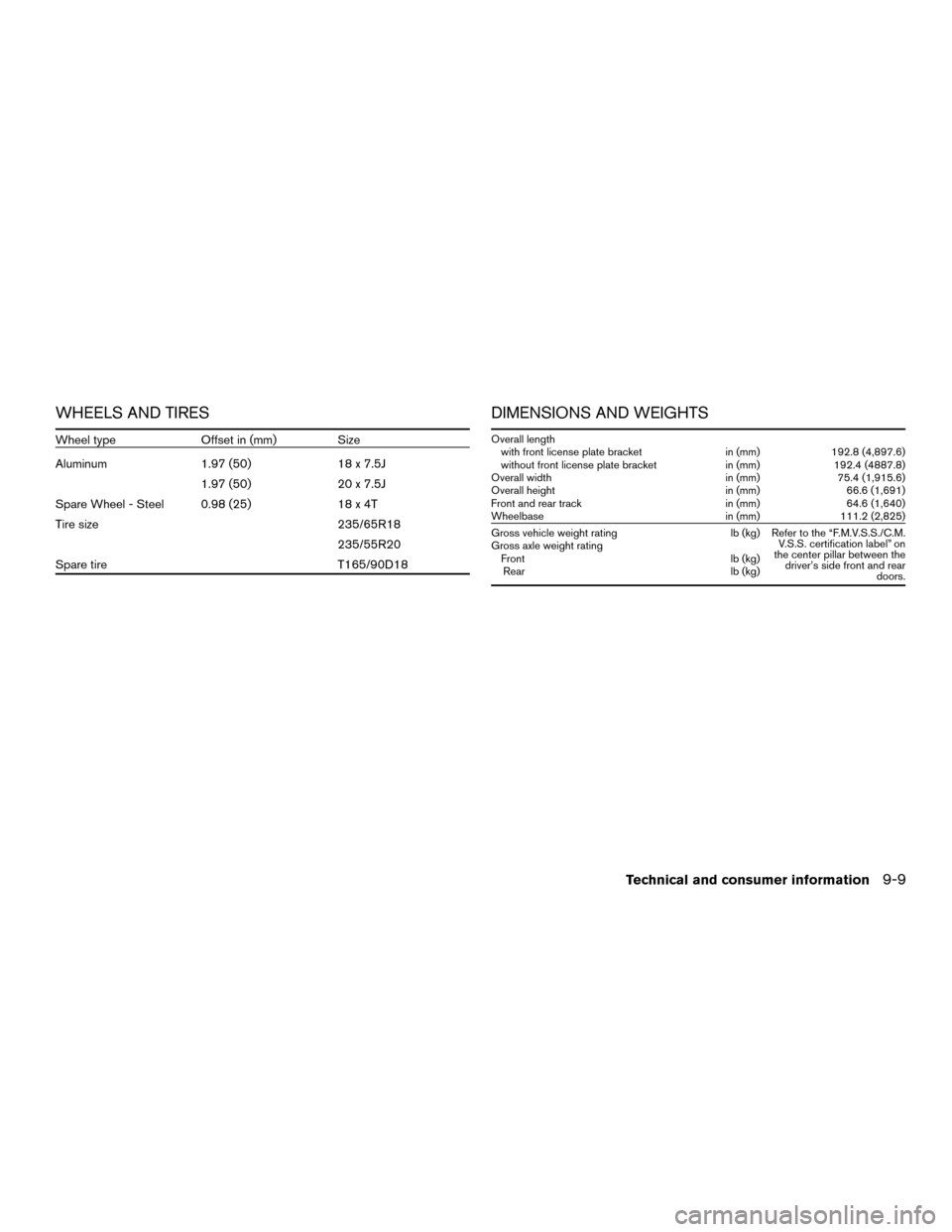
WHEELS AND TIRES
Wheel typeOffset in (mm) Size
Aluminum 1.97 (50)18 x 7.5J
1.97 (50) 20 x 7.5J
Spare Wheel - Steel 0.98 (25) 18 x 4T
Tire size 235/65R18
235/55R20
Spare tire T165/90D18
DIMENSIONS AND WEIGHTS
Overall length
with front license plate bracket in (mm) 192.8 (4,897.6)
without front license plate bracket in (mm) 192.4 (4887.8)
Overall width in (mm) 75.4 (1,915.6)
Overall height in (mm) 66.6 (1,691)
Front and rear track in (mm) 64.6 (1,640)
Wheelbase in (mm) 111.2 (2,825)
Gross vehicle weight rating lb (kg) Refer to the “F.M.V.S.S./C.M. V.S.S. certification label” on
the center pillar between the driver’s side front and rear doors.
Gross axle weight rating
Front lb (kg)
Rear lb (kg)
Technical and consumer information9-9
Page 402 of 443
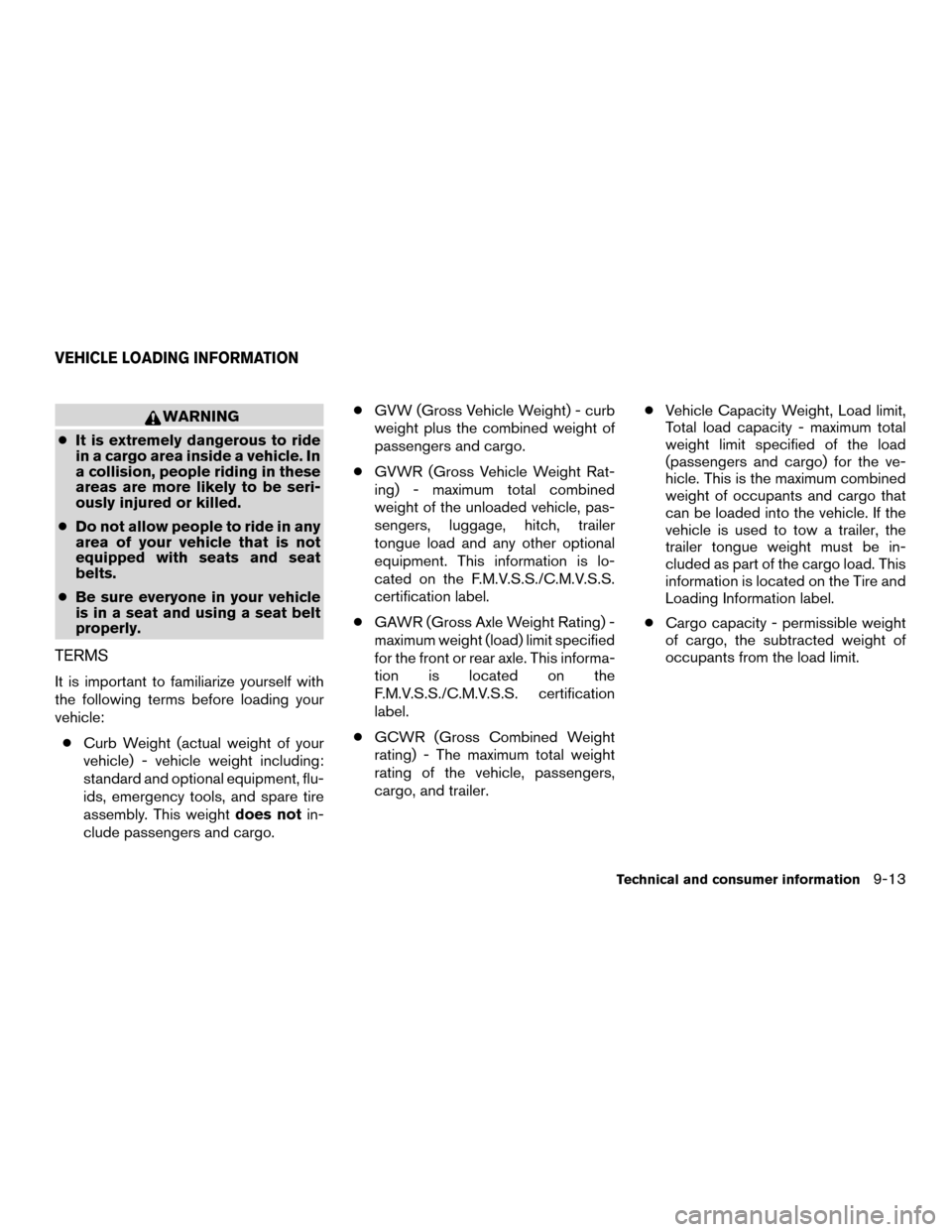
WARNING
● It is extremely dangerous to ride
in a cargo area inside a vehicle. In
a collision, people riding in these
areas are more likely to be seri-
ously injured or killed.
● Do not allow people to ride in any
area of your vehicle that is not
equipped with seats and seat
belts.
● Be sure everyone in your vehicle
is in a seat and using a seat belt
properly.
TERMS
It is important to familiarize yourself with
the following terms before loading your
vehicle:
● Curb Weight (actual weight of your
vehicle) - vehicle weight including:
standard and optional equipment, flu-
ids, emergency tools, and spare tire
assembly. This weight does notin-
clude passengers and cargo. ●
GVW (Gross Vehicle Weight) - curb
weight plus the combined weight of
passengers and cargo.
● GVWR (Gross Vehicle Weight Rat-
ing) - maximum total combined
weight of the unloaded vehicle, pas-
sengers, luggage, hitch, trailer
tongue load and any other optional
equipment. This information is lo-
cated on the F.M.V.S.S./C.M.V.S.S.
certification label.
● GAWR (Gross Axle Weight Rating) -
maximum weight (load) limit specified
for the front or rear axle. This informa-
tion is located on the
F.M.V.S.S./C.M.V.S.S. certification
label.
● GCWR (Gross Combined Weight
rating) - The maximum total weight
rating of the vehicle, passengers,
cargo, and trailer. ●
Vehicle Capacity Weight, Load limit,
Total load capacity - maximum total
weight limit specified of the load
(passengers and cargo) for the ve-
hicle. This is the maximum combined
weight of occupants and cargo that
can be loaded into the vehicle. If the
vehicle is used to tow a trailer, the
trailer tongue weight must be in-
cluded as part of the cargo load. This
information is located on the Tire and
Loading Information label.
● Cargo capacity - permissible weight
of cargo, the subtracted weight of
occupants from the load limit.
VEHICLE LOADING INFORMATION
Technical and consumer information9-13
Page 425 of 443
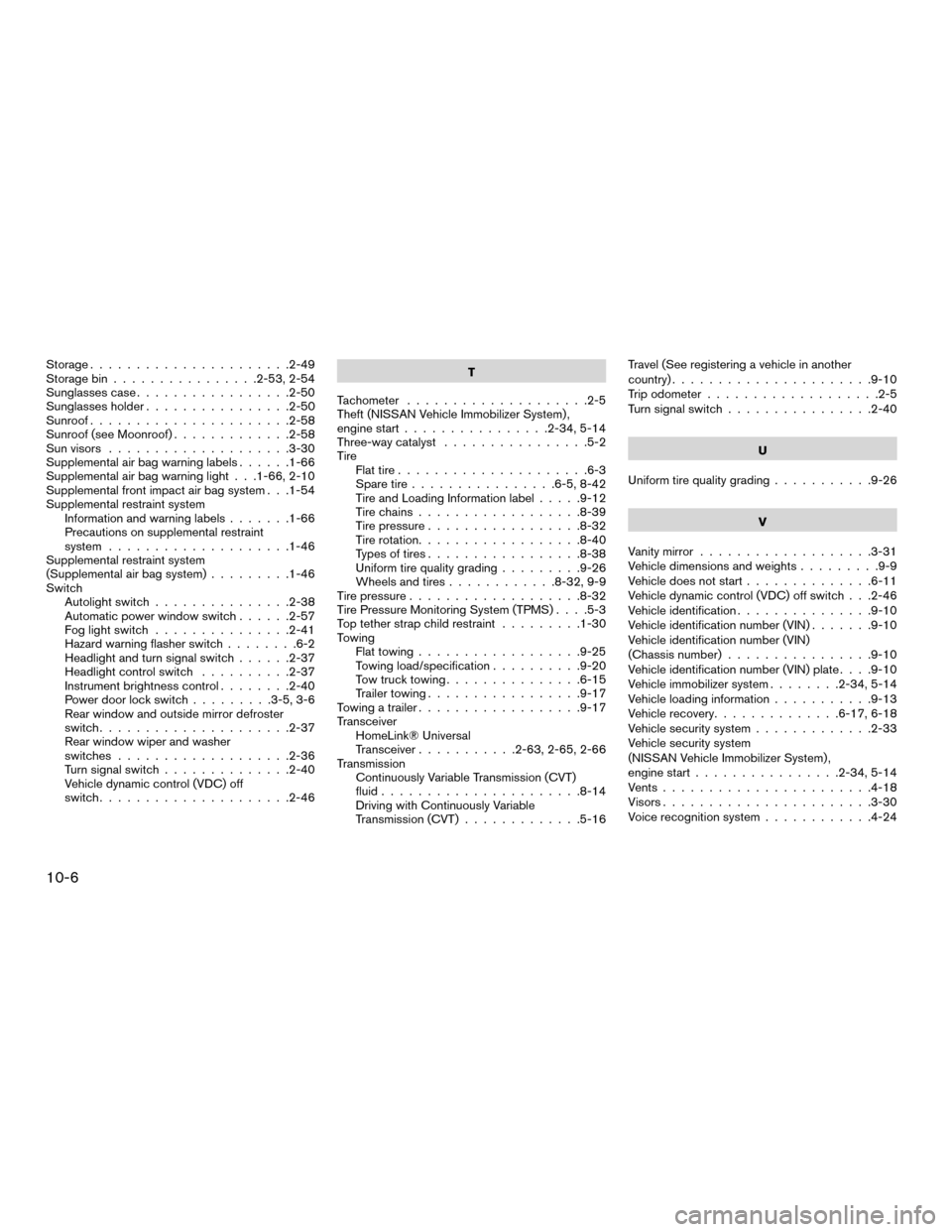
Storage......................2-49
Storage bin ................2-53, 2-54
Sunglasses case .................2-50
Sunglasses holder ................2-50
Sunroof ......................2-58
Sunroof (see Moonroof) .............2-58
Sun visors ....................3-30
Supplemental air bag warning labels ......1-66
Supplemental air bag warning light . . .1-66, 2-10
Supplemental front impact air bag system . . .1-54
Supplemental restraint system Information and warning labels .......1-66
Precautions on supplemental restraint
system ....................1-46
Supplemental restraint system
(Supplemental air bag system) .........1-46
Switch Autolight switch ...............2-38
Automatic power window switch ......2-57
Fog light switch ...............2-41
Hazard warning flasher switch ........6-2
Headlight and turn signal switch ......2-37
Headlight control switch ..........2-37
Instrument brightness control ........2-40
Power door lock switch .........3-5, 3-6
Rear window and outside mirror defroster
switch .....................2-37
Rear window wiper and washer
switches ...................2-36
Turn signal switch ..............2-40
Vehicle dynamic control (VDC) off
switch .....................2-46 T
Tachometer ....................2-5
Theft (NISSAN Vehicle Immobilizer System) ,
engine start ................2-34, 5-14
Three-way catalyst ................5-2
Tire Flat tire .....................6-3
Spare tire ................6-5, 8-42
Tire and Loading Information label .....9-12
Tire chains ..................8-39
Tire pressure .................8-32
Tire rotation ..................8-40
Types of tires .................8-38
Uniform tire quality
grading .........9-26
Wheels and tires ............8-32, 9-9
Tire pressure ...................8-32
Tire Pressure Monitoring System (TPMS) . . . .5-3
Top tether strap child restraint .........1-30
Towing Flat towing ..................9-25
Towing load/specification ..........9-20
Tow truck towing ...............6-15
Trailer towing .................9-17
Towing a trailer ..................9-17
Transceiver HomeLink® Universal
Transceiver ...........2-63, 2-65, 2-66
Transmission Continuously Variable Transmission (CVT)
fluid ......................8-14
Driving with Continuously Variable
Transmission (CVT) .............5-16 Travel (See registering a vehicle in another
country)
......................9-10
Trip odometer ...................2-5
Turn signal switch ................2-40
U
Uniform tire quality grading ...........9-26
V
Vanity mirror ...................3-31
Vehicle dimensions and weights .........9-9
Vehicle does not start ..............6-11
Vehicle dynamic control (VDC) off switch . . .2-46
Vehicle identification ...............9-10
Vehicle identification number (VIN) .......9-10
Vehicle identification number (VIN)
(Chassis number) ................9-10
Vehicle identification number (VIN) plate . . . .9-10
Vehicle immobilizer system ........2-34, 5-14
Vehicle loading information ...........9-13
Vehicle recovery ..............6-17, 6-18
Vehicle security system .............2-33
Vehicle security system
(NISSAN Vehicle Immobilizer System) ,
engine start ................2-34, 5-14
Vents .......................4-18
Visors .......................3-30
Voice recognition system ............4-24
10-6